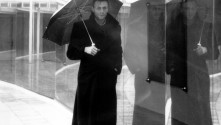
The Steamroller and the Violin
Voyage in Time
Tarkovsky’s diploma film hews to social realism, but the unabashedly lyrical treatment of an otherwise conventional story of a young violinist’s friendship with a laborer is flush with the burgeoning auteur’s signature motifs: the rain-slicked reflections, a mirror in which a boy confronts his mother, and the implied yearning for a father figure. For all its intimations of a mature style, though, The Steamroller and the Violin is perhaps most fascinating for the opportunity to see the Tarkovsky’s treatment of urban space—a kaleidoscopic vision of Moscow evoking Vertov. The film’s cinematographer (Vadim Yusov), co-writer (Andrei Konchalovsky), and composer (Vyacheslav Ovchinnikov) would all continue to play instrumental roles in Tarkovsky’s subsequent features.
Filmed as Tarkovsky conceptualized Nostalghia with famed Italian screenwriter Tonino Guerra, Voyage in Time is an exterior portrait of the Russian director’s creative process and a document of his dislocation. A relaxed atmosphere prevails as the denim-clad auteur reflects on his favorite filmmakers and Guerra reads from his poetry. They travel Italy together on a quixotic search for possible locations; after touring cathedrals and palaces, Tarkovsky finally responds most to a darkened hotel room. The documentary conveys the supreme importance of setting in Tarkovsky’s films, with the added poignancy that as the director comes to terms with the place of Italy in his upcoming film he is also struggling to understand his own place in Italy.













